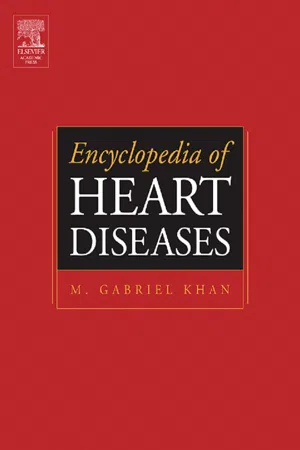
- 680 pages
- English
- ePUB (mobile friendly)
- Available on iOS & Android
Encyclopedia of Heart Diseases
About this book
The Encyclopedia of Heart Diseases is an accurate and reliable source of in-depth information on the diseases that kill more than 12 million individuals worldwide each year. In fact, cardiovascular diseases are more prevalent than the combined incidence of all forms of cancer, diabetes, asthma and leukemia. In one volume, this Encylopedia thoroughly covers these ailments and also includes in-depth analysis of less common and rare heart conditions to round out the volume's scope. Researchers, clinicians, and students alike will all find this resource an invaluable tool for quick reference before approaching the primary literature.* Coverage of more than 200 topics, including: applied pharmacology of current and experimental cardiac drugs, gene therapy, MRI, electron-beam CT, PET scan put in perspective, cardiac tests costs and justification, and new frontiers in cardiovascular research* More than 150 helpful figures and illustrations!* Dr. Khan is a well-published and respected expert in heart and heart diseases
Frequently asked questions
- Essential is ideal for learners and professionals who enjoy exploring a wide range of subjects. Access the Essential Library with 800,000+ trusted titles and best-sellers across business, personal growth, and the humanities. Includes unlimited reading time and Standard Read Aloud voice.
- Complete: Perfect for advanced learners and researchers needing full, unrestricted access. Unlock 1.4M+ books across hundreds of subjects, including academic and specialized titles. The Complete Plan also includes advanced features like Premium Read Aloud and Research Assistant.
Please note we cannot support devices running on iOS 13 and Android 7 or earlier. Learn more about using the app.
Information
I. THE SIZE OF THE PROBLEM
II. EFFECTS OF AGING ON THE HEART AND VASCULAR SYSTEM
A. Gross Anatomy
B. Histological Changes
C. Biochemical Changes
D. Electrical Conduction System
E. Valvular Changes
III. CARDIOVASCULAR THERAPY IN THE ELDERLY
A. Thrombolytic Therapy
B. Percutaneous Intervention
C. Beta-Blocker Therapy
Table of contents
- Cover image
- Title page
- Table of Contents
- Copyright
- Dedication
- ABOUT THE AUTHOR
- PREFACE
- ACKNOWLEDGMENTS
- Chapter 1: Aging and the Heart
- Chapter 2: Alcohol and the Heart
- Chapter 3: Altitude and Pulmonary Edema
- Chapter 4: Anatomy of the Heart and Circulation
- Chapter 5: Anderson-Fabry Disease
- Chapter 6: Anemia and the Heart
- Chapter 7: Aneurysm
- Chapter 8: Angina
- Chapter 9: Angioplasty/Coronary Balloon
- Chapter 10: Angiotensin-Converting Enzyme Inhibitors/Angiotensin Receptor Blockers
- Chapter 11: Antihistamines
- Chapter 12: Antioxidants
- Chapter 13: Antiphospholipid Antibody Syndrome
- Chapter 14: Antiplatelet Agents
- Chapter 15: Arginine and the Heart
- Chapter 16: Arrhythmias/Palpitations
- Chapter 17: Arteriosclerosis
- Chapter 18: Artificial Heart
- Chapter 19: Aspirin for Heart Disease
- Chapter 20: Atherosclerosis/Atheroma
- Chapter 21: Athletes and Sudden Cardiac Death
- Chapter 22: Atrial Fibrillation
- Chapter 23: Atrial Septal Defect
- Chapter 24: B-Type Natriuretic Peptide
- Chapter 25: Beriberi Heart Disease
- Chapter 26: Beta-Blockers
- Chapter 27: Blood Clots
- Chapter 28: Blood Pressure
- Chapter 29: Brugada Syndrome
- Chapter 30: Bundle Branch Block
- Chapter 31: Caffeine and the Heart
- Chapter 32: Calcium Antagonists
- Chapter 33: Carcinoid Heart Disease
- Chapter 34: Cardiogenic Shock
- Chapter 35: Cardiomyopathy
- Chapter 36: Cardiopulmonary Resuscitation (CPR)
- Chapter 37: Chagas Disease
- Chapter 38: Chelation and Heart Disease
- Chapter 39: Chemotherapy-Induced Heart Disease
- Chapter 40: Cholesterol
- Chapter 41: Coenzyme Q10
- Chapter 42: Congenital Heart Disease
- Chapter 43: Contraception and Cardiovascular Disease
- Chapter 44: Coronary Artery Bypass Surgery
- Chapter 45: C-Reactive Protein and the Heart
- Chapter 46: Cytochrome P-450
- Chapter 47: Deep Vein Thrombosis
- Chapter 48: Depression and the Heart
- Chapter 49: Diabetes and Cardiovascular Disease
- Chapter 50: Diets and Heart Disease
- Chapter 51: Diuretics
- Chapter 52: Down Syndrome
- Chapter 53: Dyslipidemia
- Chapter 54: Echocardiography
- Chapter 55: Effects of Smoking and Heart Disease
- Chapter 56: Electrocardiography
- Chapter 57: Embryology
- Chapter 58: Endocarditis
- Chapter 59: Endocrine Disorders and the Heart
- Chapter 60: Erectile Dysfunction and the Heart
- Chapter 61: Exercise and the Heart
- Chapter 62: Gene Therapy
- Chapter 63: Heart Attacks
- Chapter 64: Heart Failure
- Chapter 65: Hemochromatosis
- Chapter 66: Herbal, Dietary Supplements, and Cardiovascular Disease
- Chapter 67: HIV and the Heart
- Chapter 68: Homocysteine and Cardiovascular Disease
- Chapter 69: Hypertension
- Chapter 70: Hypertrophy of the Heart
- Chapter 71: Kawasaki Heart Disease
- Chapter 72: Miscellaneous Disorders
- Chapter 73: Murmurs and Heart Disease
- Chapter 74: Nonsteroidal Anti-Inflammatory Drugs
- Chapter 75: Obesity and Heart Disease
- Chapter 76: Pacemakers
- Chapter 77: Patent Foramen Ovale
- Chapter 78: Pericarditis and Myocarditis
- Chapter 79: Pulmonary Arterial Hypertension
- Chapter 80: Pulmonary Embolism
- Chapter 81: Race and Cardiovascular Disease
- Chapter 82: Sleep and the Heart
- Chapter 83: Stents
- Chapter 84: Stress and Heart Disease
- Chapter 85: Stroke/Cerebrovascular Accident
- Chapter 86: Syncope
- Chapter 87: Tests for Heart Diseases
- Chapter 88: Thyroid Heart Disease
- Chapter 89: Valve Diseases
- Chapter 90: Ventricular Fibrillation
- Chapter 91: Women and Heart Disease
- APPENDIX A
- APPENDIX B
- GLOSSARY
- INDEX